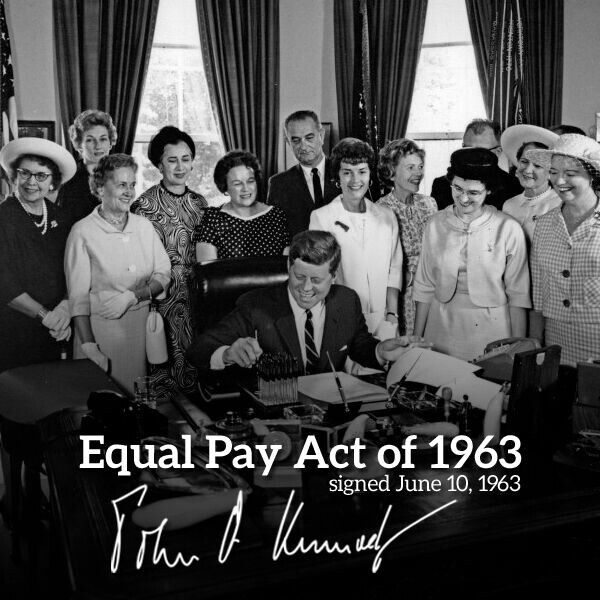In the United States of America, the gender wage gap is based on the statistic that a woman earns approximately $0.77 for every $1.00 that a man earns, but not many people understand how this figure is derived or what it even shows.1 By taking the median amount of earnings that women make in a single year and dividing this figure by the median amount of earnings that men make in a single year, the gap is revealed; however, this gap does not mean that, for the same work and qualifications, a woman will be paid $0.77 for every $1.00 that a man makes; this has been outlawed for decades: The 88th Congress of the United States passed the 1963 Equal Pay Act, which makes sex discrimination in the workforce illegal, and this law has been in effect for over fifty years.2 In addition, Harvard economist Claudia Goldin has stated that “the gender gap in wages is closing.”3 With this in mind, the question remains: why is there still a wage gap?

While it is true that there is a gap between the amount of money that men and women earn, the gap does not exist primarily because of sexism or discrimination (although this, unfortunately, is still a factor); instead, it is mainly because of the different life choices that the average man and the average woman make.
The data shows that men and women tend to go into different career fields. For example, women tend to go into the health services and social services sectors, while men tend to go into fields relating to science, technology, engineering, and mathematics (STEM).4 With regards to how the wage gap is calculated (dividing the median amount of earnings per year that a woman makes by the median amount of earnings per year that a man makes), it makes sense that there is a wage disparity if men tend to go into STEM fields while women tend to go into jobs relating to health and social services sectors.5 One could argue that more men go into STEM-related fields than women because of sexism or discrimination, and this may have been a valid point in the past; however, in recent years, the evidence reveals the opposite: women are prioritized in fields relating to STEM precisely because men tend to dominate in STEM-related careers. In fact, females are approximately two times as likely to be chosen over equally qualified men for STEM faculty positions.6 Further data from the Washington Post reveals that, even though the evidence shows that men tend to dominate in STEM fields, this is not primarily due to sexism or discrimination: “This is the latest in a series of studies by the Cornell researchers, many of which have concluded that the scarcity of female faculty in science departments (about 20 percent in most fields) can’t be blamed on innate sexism. In a study published in the journal Psychological Science in the Public Interest, they found that young and mid-career women are more likely to receive job offers than male candidates, are paid roughly the same amount, are granted tenure and promoted at the same rate (except in economics), remain in their fields for the same amount of time, and are about as satisfied with their jobs. The study attributes the lack of female scientists to early educational choices — like opting not to take Advanced Placement calculus and physics in high school or choosing not to declare a math-intensive major in college — rather than discrimination later on.”7
Regardless of where one is on planet earth, there will always be 24 hours in a day, 168 hours in a week, and 8,760 hours per year. Even though these numbers are the same for everyone on earth, everyone uses them differently in the workweek. For example, the average man working full time works 8.2 hours per day, while the average full-time woman works 7.8 hours per day. If men and women are compared further (without taking into account part-time work), then it’s revealed that men tend to work an average of 42 more minutes than women; although 42 minutes might not seem like much time, it does translate into many hours in the long run: an additional 42 minutes per day at work means that men, on average, are working 3.5 hours more than women per week, or an additional 14 hours per month.8 This extra amount of time means that men will be paid more money than women, since, on average, they work more than women. With this in mind, when calculating the earnings of women compared to the earnings of men, the disparity in wage makes sense.
Why is it that there is a vast disparity between the men and women in professional sports in the United States of America? The median salary for a player in the National Basketball Association (NBA) in 2015 was $2,505,720.9 The median salary for a player in the Women’s National Basketball Association (WNBA) is approximately $71,635.10 Even though both a woman from the WNBA and a man from the NBA are playing the same game, why is there a massive gap in the amount of money made? It appears that the answer can be derived from economics. With regard to economics, there are two forces at play: the law of supply and the law of demand. The law of demand states that there is an inverse relationship between price and quantity demanded.11 In other words, the more expensive a product becomes, the less likely consumers are to purchase it. The law of supply states that there is a positive relationship between price and quantity supplied.12 This means that if a supplier of a product realizes that the demand for a product is high, then the supplier can charge more money because he or she knows that people will pay for the product. Because the NBA knows the demand to see their games is high, the supplier (the NBA) can charge a lot of money for their tickets. On the other hand, the WNBA is not as popular compared to the NBA. Because the demand for WNBA games is not as high as NBA games, the supplier cannot charge as much money compared to the NBA, which means that the WNBA players will not make as much as NBA players. Another reason why NBA players tend to make more money is that their season is 82 games, while the WNBA players’ season is only 18 games; this means that there is more time for money to be collected for NBA players than in the WNBA. As can be seen, the disparity in money from an NBA player’s salary and a WNBA player’s salary has little to do with sexism or discrimination and everything to do with the way economics works.

It seems that the wage gap is primarily a product of multiple factors, such as the choice of job that the average man or the average woman takes, the number of hours that the average man and the average woman works, and because of economics. Having said this, what happens when these factors are accounted for? If the equation to find the gender wage gap accounts for these variables, then there is a small disparity between the amount of money that a man makes versus the amount of money that a woman makes. This small disparity seems like, unfortunately, a product of sexism and discrimination. One major form of discrimination in the workforce that women face is vertical (or hierarchical) segregation, which “refers to the fact that men are much more likely than women to be in positions of authority.”13 However, the United States government and businesses have begun to take notice of this and are now trying to do their best to reduce this form of discrimination. For example, women now own approximately half of all the United States companies.14 Also, President Barack Obama signed the Lilly Ledbetter Fair Pay Act in 2009, which made it much more difficult for businesses to take advantage of women by not paying them their fair share.15 This shows that, while discrimination and sexism play a role in a part of the wage gap, it is, thankfully, dying out and becoming less and less of a problem.

The gender wage gap is a complex issue. While it is still a problem in the United States of America, great strides are being made to reduce it. The gender wage gap appears to have multiple components, such as the amount of time working, the jobs that men and women go into, and, in part, economics. However, after accounting for this, there seems to be a percentage of the wage gap that doesn’t disappear; this percentage seems to be derived from sexism and discrimination. With this said, there is hope: laws have been passed in recent years to combat this unfortunate case of sexism and discrimination, and the workforce is more pro-women than at any other point in the history of the United States of America.16 Additionally, there is a global effort to reduce the inequality between man and woman: The United Nations adopted the Universal Declaration for Human Rights in 1948, which states that everyone has the right to equal pay for the same work.17 Although it is unfortunate that there is still a wage gap, there is a good trend in America with regards to the gender wage gap: it is decreasing. Hopefully, one day, the wage gap will be a thing of the past.
- Encyclopedia of Social Problems, 2008, s.v. “Wage Gap,” by Vincent N Parrillo. ↵
- The Wiley Blackwell Encyclopedia of Family Studies, 2016, s.v. “Gender Wage Gap,” by Emira Danad. ↵
- Reihan Salam, “Which Gender Gap?” National Review 66, no. 1 (January 27, 2014): 19-20. ↵
- “Students in STEM Fields by Gender and Race/Ethnicity,” CollegeBoard, https://trends.collegeboard.org/education-pays/figures-tables/students-stem-fields-gender-and-race-ethnicity. ↵
- Kerry Close, “STEM Majors Will Earn Highest Salaries This Year,” Time, January 21, 2016, http://time.com/money/4189471/stem-graduates-highest-starting-salaries/. ↵
- Ted Boscia, “Women Preferred 2:1 Over Men for STEM Faculty positions, “Cornell Chronicle, April 13, 2015, http://news.cornell.edu/stories/2015/04/women-preferred-21-over-men-stem-faculty-positions. ↵
- Sarah Kaplan, “Study Finds, Surprisingly, That Women Are Favored for Jobs in STEM,” The Washington Post, April 14, 2005, https://www.washingtonpost.com/news/morning-mix/wp/2015/04/14/study-finds-surprisingly-that-women-are-favored-for-jobs-in-stem/?noredirect=on&utm_term=.1be2c8a73649. ↵
- Karin Agness, “New Report: Men Work Longer Hours Than Women,” Forbes, June 30, 2016, https://www.forbes.com/sites/karinagness/2016/06/30/new-report-men-work-longer-hours-than-women/#7166f2e518b4. ↵
- Tome Gerencer, “How Much Money Does an NBA Player Make?” Money Nation, November 13, 2016, http://moneynation.com/how-much-money-does-an-nba-player-make/. ↵
- Paulana Lamonier, “The Business Of Being A WNBA Player,” Forbes, July 2, 2018, https://www.forbes.com/sites/plamonier/2018/07/02/the-business-of-being-a-wnba-player/#11d4d5c35af1. ↵
- Timothy Taylor, Courseware Print Companion for Micro Economics (unknown, 2016), 19. ↵
- Timothy Taylor, Courseware Print Companion for Micro Economics (unknown, 2016), 20. ↵
- Encyclopedia Britannica, 2018, s.v. “Gender wage gap,” by Medora W. Barnes. ↵
- Williams G. Nickels, James M. McHugh, and Susan M. McHugh, Understanding Business 12th Edition (New York: McGraw-Hill Education, 2016), 130. ↵
- From Suffrage to the Senate: America’s Political Women, 2013, s.v. “Lilly Ledbetter Fair Pay Act of 2009,” by Suzanne O’Dea. ↵
- Bryce Covert, “Closing the Wage Gap for Women,” New Republic, no. 249 (July 2018): 4-6. ↵
- Gale Encyclopedia of U.S. Economic History, 2015, s.v. “Gender Wage Gap,” by Ermira Danaj. ↵



44 comments
Katherine Wolf
I remember being told that the pay gap doesn’t actually exist because the people doing the calculations didn’t factor in the time women take off to have kids. That hypothesis always bugged me because it seemed too simple. I am glad to be educated that the wage gape is a complex issue and that many things have and are being done to correct it.
Tyler Reynolds
The article was well structure and formatted. It used a series of good accurate source and deserves a award. I like how the author explored the various factors that contributed to the wage gap but I do believe there are some that she missed. For one, the ongoing events and culture surrounding a workplace and the U.S. play as major factors in determining whether a company is willing or wants to hire more women. I remember reading a article about how the recent “MeToo” movement motivated people on wall street to either hire less women or adopt more strict guidelines regarding the interaction with women within wall street. This of course was to ensure that there would be less sexual harassment claims that would emerge, damaging the company’s reputation and costing them a fair sum of money.
Leeza Cordova
Many different aspects can affect the wage gap and this article did a good job of covering many of them. However, one of the reasons that I have heard that is not talked about much is the idea that men might have “more experience”. We talked about this idea in my social stratification class, and although I do not completely agree with it, it made good points. It included the idea that men might have the upperhand in some jobs due to the fact that most of them do not have to take off for childbirth or have to take years away from work to tend to a child, thus making them be in a certain field longer with more experience.
Mariah Garcia
This was an interesting article! It is interesting to see how many different factors go into affecting the wage gap, especially the hours worked per day, month and year. That statistic in particular proved to be very sobering as it provided an information that I wasn’t aware of, and it is interesting to see how the data may be skewed based on the number of men who go into health and social service professions.
Avery Mascorro
I feel like this article made many great points in the way of explaining that not all of the wage gap is due to just discrimination and sexism. I also feel like the article did not shed enough light on the discrimination that does exist. It just kind of grazed over the idea, and didn’t give the actual problem enough of a look. I feel like we are definitely making strides in legislation that makes it harder for intentional wage gaps to exist, but many things passed are easy to work around and still are.
Alicia Guzman
While I understand that there is legislation in place like the Universal Declaration for Human Rights (1948) by the United Nations and the United States’ Equal Pay Act of 1963, they have barely, in my opinion, made an impact. It has been fifty-six years since the Equal Pay Act of 1963 and the wage gap still exists. There is still a thirty-three-cent wage difference. While men and women may typically go into different fields there is still a wage gap in the same fields. My aunt and uncle have been teachers for years and while my aunt has a Ph.D. and my uncle has a master’s degree, my uncle makes more. That does not seem equal to me. What will our generation do and demand from one another for each other?
Octaviano Huron
I found this article to be very intriguing. It was interesting to find out about the reasons behind the gender wage gap, including working hours and popularity of the career to the general public, but it is a problem that is still trying to be eradicated. Fortunately, this issue is, albeit gradually, closing to provide equal pay to both men and women.
Paola Arellano
It is unfortunate that this is still a topic being discussed in 2019 but like stated in the article, there are changes being made to solve these issues. The wage gap has been a controversial topic for centuries going all the way back to the making of the 19th amendment to the Constitution of the United States. Women were suppressed and silenced for far too long and it is nice to see a positive outcome come from the long fight of many women. I did think that this article was a little repetitive and had a weak conclusion however it truly educated me on a subject that I did not know enough about.
Andres Cano
I appreciated the points that the author brought up when considering the causes of this “wage gap”, especially the amount of hours that men/women work. I think that by comparing long hours vs. short hours, you’re comparing different jobs with different salaries, which amounts purely to job choice, not choice of hours working. The author certainly understood that sexual discrimination not only means equal pay, but also equal opportunity. If I ever encounter unequal opportunity in my workplace, I will surely work towards ending it. However, I also feel reassured that the likelihood of encountering this is diminishing.
Engelbert Madrid
I enjoyed reading this article, because it gives a better understanding of where the gender wage gap is coming from. Before reading this article, I didn’t have enough knowledge about gender wage gap, and I thought it had to do mostly because of sexism and discrimination. However, the article does a great job on providing enough evidence and information that lets the reader understand the problem of gender wage gap.